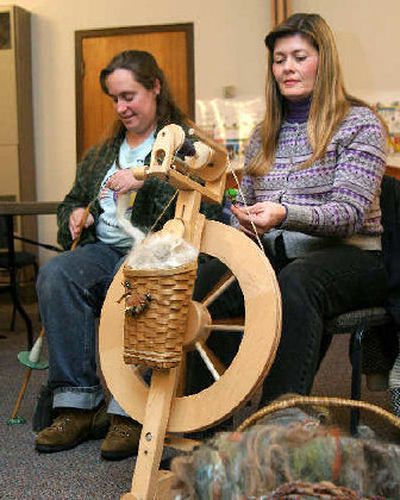Spinning clubs bring members together for creativity, friendship

The ancient art of spinning is back in vogue with clubs forming across the region that give folks a chance to socialize and share in a creative outlet.
Twice a month in Rose Lake up to 25 women bring their portable spinning wheels, drop spindles, knitting and weaving projects or just plain fiber to the gathering.
At this gathering, it was fiber night, and many of the ladies brought in raw fiber or fiber they had spun – fiber that was hand-dyed and colorful or left plain and original and spun into degrees of thickness from yarn to thread or even silk.
Fibers such as that from angora goats is called mohair; angora rabbits produce angora, and alpaca is thought by many to be the warmest and softest wool in the world. Additionally, many spin more exotic fibers such as camel and buffalo hair to create unique textures.
Many of the spinners lug their projects around in coffee shops, hospitals and lunch breaks.
“It is a great conversation piece,” says Suzy Showen. She took along a beautiful golden metal-weighted drop spindle when she visited her husband in the hospital.
The drop spindle was first used to draft fiber into yarn or thread.
“It is an ancient craft dating before Christ was born and is once again gaining popularity today for it ease and portability,” says Showen as she drops and spins on hers. The drop spindle or hand spindle looks like a top toy but with a hook for the fiber to go through.
Drop spindles were used until the middle of the 15th century. Columbus’ sails were spun on a hand or a drop spindle, Showen says.
Jennifer Gookstetter, who has been spinning for 18 years, talks about buying her first wheel.
“My first wheel I bought didn’t match the house,” she explains, “so I returned it and bought one that did match the house. But the one that matches the house, I could not spin on it because it was a single drive, so I went back and got the original, and every time I went back she charged me more money.”
Today, Gookstetter now owns five wheels, including one that looks like banjo.
Many of the ladies help one another. Showen asked Karen Goodson, a longtime spinner and judge at fiber shows, if her yarn needs more twisting. This was Jill Sabrowsk’s first time spinning and Kari Berkshire helped her learn the wheel.
With two bare feet on the pedals, Sabrowski tried hard to get in the rhythm of spinning. Her yarn was unwinding and Berkshire showed her how to spin faster to wind the yarn.
New fibers like alpaca and buffalo hair are giving spinning a new romance.
“The whole process from animal to garment is interesting to me,” says Cindy Conover. “You have the option as a spinner to make it bulky or make it thin.”